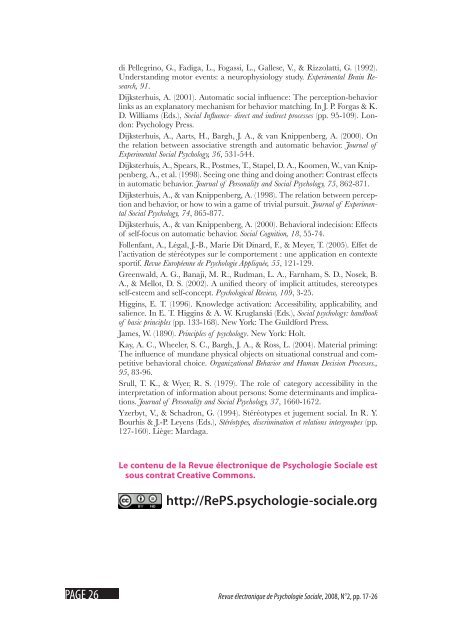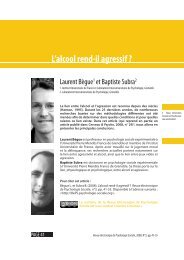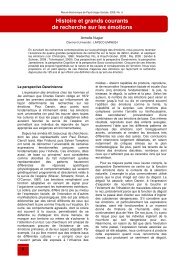Pourquoi les individus aident-ils moins autrui lorsqu'ils sont nombreux
Pourquoi les individus aident-ils moins autrui lorsqu'ils sont nombreux
Pourquoi les individus aident-ils moins autrui lorsqu'ils sont nombreux
You also want an ePaper? Increase the reach of your titles
YUMPU automatically turns print PDFs into web optimized ePapers that Google loves.
PAGE 26<br />
di Pellegrino, G., Fadiga, L., Fogassi, L., Gal<strong>les</strong>e, V., & Rizzolatti, G. (1992).<br />
Understanding motor events: a neurophysiology study. Experimental Brain Research,<br />
91.<br />
Dijksterhuis, A. (2001). Automatic social influence: The perception-behavior<br />
links as an explanatory mechanism for behavior matching. In J. P. Forgas & K.<br />
D. Williams (Eds.), Social Influence- direct and indirect processes (pp. 95-109). London:<br />
Psychology Press.<br />
Dijksterhuis, A., Aarts, H., Bargh, J. A., & van Knippenberg, A. (2000). On<br />
the relation between associative strength and automatic behavior. Journal of<br />
Experimental Social Psychology, 36, 531-544.<br />
Dijksterhuis, A., Spears, R., Postmes, T., Stapel, D. A., Koomen, W., van Knippenberg,<br />
A., et al. (1998). Seeing one thing and doing another: Contrast effects<br />
in automatic behavior. Journal of Personality and Social Psychology, 75, 862-871.<br />
Dijksterhuis, A., & van Knippenberg, A. (1998). The relation between perception<br />
and behavior, or how to win a game of trivial pursuit. Journal of Experimental<br />
Social Psychology, 74, 865-877.<br />
Dijksterhuis, A., & van Knippenberg, A. (2000). Behavioral indecision: Effects<br />
of self-focus on automatic behavior. Social Cognition, 18, 55-74.<br />
Follenfant, A., Légal, J.-B., Marie Dit Dinard, F., & Meyer, T. (2005). Effet de<br />
l’activation de stéréotypes sur le comportement : une application en contexte<br />
sportif. Revue Européenne de Psychologie Appliquée, 55, 121-129.<br />
Greenwald, A. G., Banaji, M. R., Rudman, L. A., Farnham, S. D., Nosek, B.<br />
A., & Mellot, D. S. (2002). A unified theory of implicit attitudes, stereotypes<br />
self-esteem and self-concept. Psychological Review, 109, 3-25.<br />
Higgins, E. T. (1996). Knowledge activation: Accessibility, applicability, and<br />
salience. In E. T. Higgins & A. W. Kruglanski (Eds.), Social psychology: handbook<br />
of basic princip<strong>les</strong> (pp. 133-168). New York: The Guildford Press.<br />
James, W. (1890). Princip<strong>les</strong> of psychology. New York: Holt.<br />
Kay, A. C., Wheeler, S. C., Bargh, J. A., & Ross, L. (2004). Material priming:<br />
The influence of mundane physical objects on situational construal and competitive<br />
behavioral choice. Organizational Behavior and Human Decision Processes.,<br />
95, 83-96.<br />
Srull, T. K., & Wyer, R. S. (1979). The role of category accessibility in the<br />
interpretation of information about persons: Some determinants and implications.<br />
Journal of Personality and Social Psychology, 37, 1660-1672.<br />
Yzerbyt, V., & Schadron, G. (1994). Stéréotypes et jugement social. In R. Y.<br />
Bourhis & J.-P. Leyens (Eds.), Stéréotypes, discrimination et relations intergroupes (pp.<br />
127-160). Liège: Mardaga.<br />
Le contenu de la Revue électronique de Psychologie Sociale est<br />
sous contrat Creative Commons.<br />
http://RePS.psychologie-sociale.org<br />
Revue électronique de Psychologie Sociale, 2008, N°2, pp. 17-26




